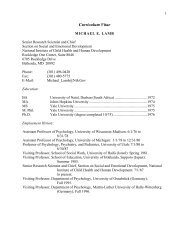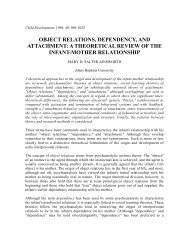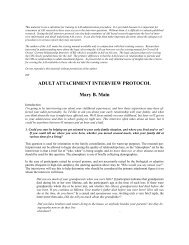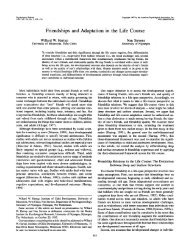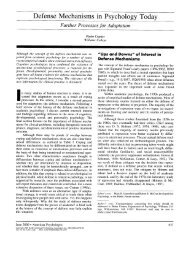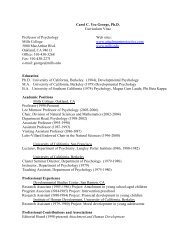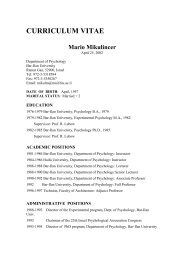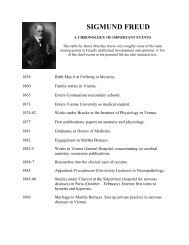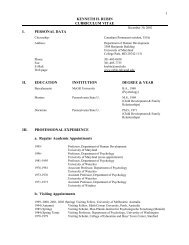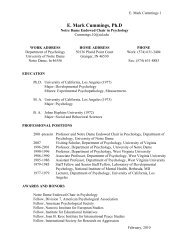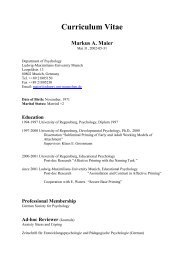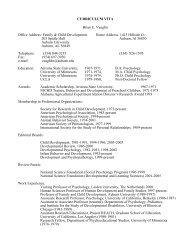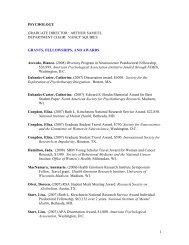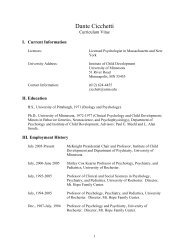the origins of attachment theory: john bowlby and mary ainsworth ...
the origins of attachment theory: john bowlby and mary ainsworth ...
the origins of attachment theory: john bowlby and mary ainsworth ...
You also want an ePaper? Increase the reach of your titles
YUMPU automatically turns print PDFs into web optimized ePapers that Google loves.
eminded her <strong>of</strong> responses Robertson had documented in children exposed to prolonged<br />
separations, <strong>and</strong> about which Bowlby (1959) had <strong>the</strong>orized in his paper on separation.<br />
A few <strong>of</strong> <strong>the</strong> I -year-olds from <strong>the</strong> Baltimore study were surprisingly angry when <strong>the</strong> mo<strong>the</strong>r<br />
returned after a 3-minute (or shorter) separation. They cried <strong>and</strong> wanted contact but would not<br />
simply cuddle or “sink in” when picked up by <strong>the</strong> returning mo<strong>the</strong>r. Instead, <strong>the</strong>y showed <strong>the</strong>ir<br />
ambivalence by kicking or swiping at her. Ano<strong>the</strong>r group <strong>of</strong> children seemed to snub or avoid <strong>the</strong><br />
mo<strong>the</strong>r on reunion, even though <strong>the</strong>y had <strong>of</strong>ten searched for her while she was gone. Analyses <strong>of</strong><br />
home data revealed that those infants who had been ambivalent toward or avoidant <strong>of</strong> <strong>the</strong> mo<strong>the</strong>r<br />
on reunion in <strong>the</strong> Strange Situation had a less harmonious relationship with her at home than<br />
those (a majority) who sought proximity, interaction, or contact on reunion (Ainsworth, Bell, &<br />
Stayton, 1974). Thus originated <strong>the</strong> well-known Strange Situation classification system<br />
(Ainsworth et al., 1978), which, to Ainsworth’s chagrin, has stolen <strong>the</strong> limelight from her<br />
observational findings <strong>of</strong> naturalistic mo<strong>the</strong>r-infant interaction patterns at home.<br />
The First Volume in <strong>the</strong> Attachment Trilogy: Attachment <strong>and</strong> Ethology<br />
While Ainsworth wrote up <strong>the</strong> findings from her G<strong>and</strong>a study for Infancy in Ug<strong>and</strong>a (1967) <strong>and</strong><br />
was engaged in collecting data for <strong>the</strong> Baltimore project, Bowlby worked on <strong>the</strong> first volume <strong>of</strong><br />
<strong>the</strong> <strong>attachment</strong> trilogy, Attachment (1969). When he began this enterprise in 1962, <strong>the</strong> plan had<br />
been for a single hook. However, as he explains in <strong>the</strong> preface: “As my study <strong>of</strong> <strong>the</strong>ory pro-<br />
gressed it was gradually borne in upon me that <strong>the</strong> field I had set out to plough so light-heartedly<br />
was no less than <strong>the</strong> one Freud had started tilling sixty years earlier.” In short, Bowlby realized<br />
that he had to develop a new <strong>the</strong>ory <strong>of</strong> motivation <strong>and</strong> behavior control, built on up-to-date sci-<br />
ence ra<strong>the</strong>r than <strong>the</strong> outdated psychic energy model espoused by Freud.<br />
In <strong>the</strong> first half <strong>of</strong> Attachment, Bowlby lays <strong>the</strong> groundwork for such a <strong>the</strong>ory, taking pains<br />
to document each important statement with available research findings. He begins by noting that<br />
organisms at different levels <strong>of</strong> <strong>the</strong> phylogenetic scale regulate instinctive behavior in distinct<br />
ways, ranging from primitive reflex-like “fixed action patterns” to complex plan hierarchies with<br />
subgoals. In <strong>the</strong> most complex organisms, instinctive behaviors may be “goal-corrected” with<br />
continual on-course adjustments (such as a bird <strong>of</strong> prey adjusting its flight to <strong>the</strong> movements <strong>of</strong><br />
<strong>the</strong> prey). The concept <strong>of</strong> cybernetically controlled behavioral systems organized as plan



